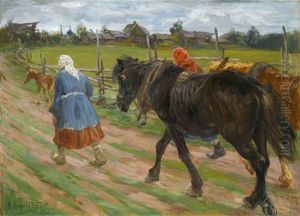Bela Barsi Paintings
Béla Barsi was a Hungarian artist known for his contributions to modern art, particularly in the realm of graphic design and painting. Born in 1907 in Hungary, Barsi studied at the Hungarian College of Fine Arts. His early work was influenced by the prevailing artistic movements of the time, including Expressionism and Constructivism. He developed a unique style that blended the geometric rigor of the latter with the more emotive qualities of the former.
During the interwar period, Barsi became part of the vibrant European art scene, where he was exposed to the works of contemporary masters and avant-garde movements. His art evolved to incorporate elements of Surrealism and Abstract Expressionism, and he gained a reputation for his innovative use of color and form. Barsi's paintings often featured abstract compositions with dynamic, swirling patterns that suggested movement and depth.
Barsi's career was tragically cut short due to the political turmoil and the outbreak of World War II in Europe. As the war escalated, Hungary found itself aligned with the Axis powers, leading to increased persecution of those seen as political dissidents or belonging to minority groups. Barsi, being of Jewish descent, became a target during the Holocaust. In 1944, Béla Barsi was deported to a concentration camp, where he perished. His exact date of death is often not precisely known, reflecting the chaos and destruction of the era.
Despite his untimely death, Barsi's work has continued to be celebrated posthumously. His contributions to modern Hungarian art have been recognized in retrospective exhibitions, and his pieces are included in the collections of several Hungarian museums. Barsi's artistic legacy is a testament to the vibrant cultural life that existed in Hungary during the early 20th century, and his work is studied for its innovative approach and its poignant reflection of an artist working during some of Europe's darkest days.


